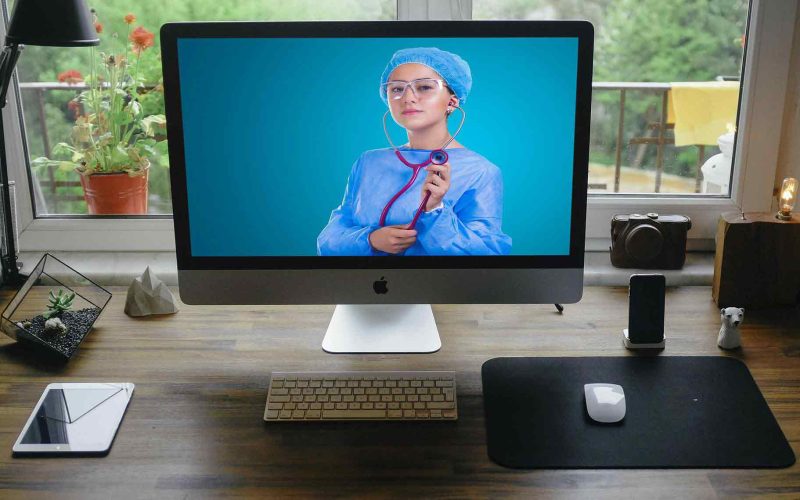How the Pandemic Shaped the Future of Telehealth

Table of Contents
Telehealth services have seen a tremendous boost during the recent global pandemic. People have preferred to consult the doctors from their safe homes via video calls. This practice and advanced technologies have improved the engagement between the healthcare providers and patients and facilitated availability of treatment to those who can’t leave their homes. However, as telehealth is still new, it faces many challenges as well. Here are the challenges and benefits of telehealth, the future of patient care. ~ Ed.

The COVID-19 pandemic brought changes for both regular people and entire industries, and the world of telehealth is a star example of that. In 2019, there were 840,000 Medicare telehealth visits; in 2020, there were over 50 million of them. Due to not only pandemic-related restrictions, but also fears over contracting diseases at crowded doctors’ offices, many people opted to schedule appointments via telehealth platforms. The same went for therapists as well, who used teletherapy platforms to manage their practices. While the actual appointments take place via video call, there are plenty of other tools available, such as therapy scheduling software or automatic billing.
Since telehealth has expanded so quickly over the last couple of years, though, it’s experienced some growing pains along the way. Even so, they’re all issues that can be resolved with some time and common sense. Telehealth continues to be an efficient alternative to in-person doctor’s visits, and will likely continue to be for quite a while. To learn more about the advantages and challenges of using telehealth platforms, just keep reading!
5 Advantages of Using Telehealth Platforms
Telehealth bring you convenience, lower costs, fewer associated risks, and much more.
Improved engagement between healthcare providers and patients
Some health conditions, like diabetes or asthma, can be easily monitored through telehealth. If a patient needs regular check-ups, they’re a lot more likely to attend them if all they need to do is sit down in front of a computer. Chronic illnesses might not always feel severe enough to warrant frequent doctor’s appointments, but many of them need to be closely monitored anyway. With the help of relevant medical devices like blood glucose monitors or spirometers, telehealth makes remote monitoring possible.
Fewer associated risks
Even without the fear of COVID-19 keeping people away from public spaces, there’s always a higher risk of catching something contagious when you go to an in-person doctor’s appointment. Those who are especially young, old, or immunocompromised take an even bigger risk. If the visit can be made via video call, however, that eliminates the danger of contracting something for the sake of a 15- or 30-minute chat with the doctor.
Related Posts
Convenience
This is probably one of the most obvious benefits of telehealth. Not only does a virtual appointment save you the trouble of driving to and from a physical office, but it also eliminates the need to worry about related logistics: who’ll be watching the kids, will there be bad traffic along the way, will I need to bring any documents, and so on. Plus, a lot of people use telehealth services to access better-quality healthcare than what’s available in their area. As long as they have a decent internet connection, they don’t have to worry about driving for hours from a rural area, or making do with sub-par local options.
Lower costs
Although telehealth visits don’t necessarily cost less than trips to a brick-and-mortar healthcare facility, you will get to skip all the associated costs. You won’t have to pay for gas or public transport, parking, time spent away from your job, or childcare, and that adds up, especially with frequent appointments.
Advancing technologies
Prior to the pandemic, the options for comprehensive telehealth platforms were fairly limited. Thanks to rapidly rising demand, however, there are now more choices than ever, with constant improvements being made to meet the needs of both doctors and patients. Instead of being a second-best option to in-person visits, telehealth appointments are now viable alternatives for all kinds of medical-related purposes.
5 Challenges for Telehealth Platforms
Being in its infancy, telehealth has its share of challenges regarding technology, regulations, and more.
1. HIPAA compliance
Even though the established telehealth platforms are all HIPAA-compliant, some healthcare professionals are unknowingly using video call services that don’t sufficiently protect patient privacy. In order to be HIPAA-compliant, a platform has to use end-to-end encryption for video calls, as well as strict digital security protocols if patient data is being stored on the platform. Cyber attacks are a risk for any site, but medical files have the potential to cause a lot of damage if they’re stolen.
2. IT resource limitations
Offering telehealth services to a medical or therapy practice takes a lot more than just setting up video calls. In most cases, it requires plenty of work from the IT team to keep it up and running – and available to however many patients need it. If the number of telehealth appointments increases drastically (as it has for so many medical practices), this will stretch IT resources, and could even cause delays due to inadequate personnel, budgets, or facilities.
Related Posts
3. Scalability
Along the same lines, expanding telehealth practices require more space, more money, and more equipment in order to function smoothly. If an existing telehealth practice has reached its limits, the healthcare providers will have to choose between making do with what they’ve got, or updating their offerings with room to grow. This was an issue for many healthcare providers during the pandemic, and it probably will be for as long as telehealth continues to increase in popularity.
4. Data Mobility
A key part of managing workflow is data mobility: who gets to access it, who gets to change it, and how does it get transferred, if at all. From patient records to back-office notes, a telehealth platform doesn’t just need to keep information secure; it also needs to streamline data mobility, so that it’s available to whoever needs it, whenever they need it.
5. Health insurance regulations
Some telehealth appointments are covered by select health insurance plans, but current regulations don’t look at telehealth and in-person doctor’s visits the same way. Some people are able to use their health insurance to pay for a physical trip to the doctor’s office, but not for a telehealth appointment. However, it’s thought that the increasing use of telehealth for routine medical care will eventually change the way health insurance companies establish coverage.
The takeaway
Telehealth has always had a lot of potential, but the pandemic gave people a reason to take advantage of its many uses. Even when the pandemic becomes part of the past, experts think that doctors, therapists, psychiatrists, and other healthcare professionals will continue to use telehealth as an integral part of providing medical care.
Over to you
How is your experience with telehealth platforms? Share them in the comments section.
Disclaimer: We're not offering any medical advice here. These ideas are for educational and entertainment purposes only. Always seek a professional medical opinion from a physician of your choosing before making any medical decision. The information provided here is not intended to be a substitute to the advice given by your physician or another healthcare professional.
Disclaimer: Though the views expressed are of the author’s own, this article has been checked for its authenticity of information and resource links provided for a better and deeper understanding of the subject matter. However, you're suggested to make your diligent research and consult subject experts to decide what is best for you. If you spot any factual errors, spelling, or grammatical mistakes in the article, please report at [email protected]. Thanks.



















Excellent article! The pandemic indeed acted as a catalyst for the rapid adoption and evolution of telehealth. It’s remarkable to see how quickly both healthcare providers and patients have embraced this technology out of necessity, leading to significant advancements that are likely to have lasting effects.
I particularly appreciate how you highlighted the increased accessibility telehealth provides. For individuals in remote areas or those with mobility issues, being able to consult with healthcare professionals from home is a major benefit. This convenience not only improves access to care but also enhances patient compliance with treatment plans
The improved engagement between healthcare providers and patients through telehealth platforms is a game-changer in modern healthcare. By leveraging technology to enhance communication, convenience, and collaboration, telehealth offers numerous advantages for both patients and providers alike. From the convenience of virtual consultations to the ability to track health metrics remotely, telehealth platforms empower individuals to take control of their health and receive personalized care from the comfort of their own homes. This not only leads to better health outcomes but also fosters stronger relationships between patients and providers. Overall, telehealth is revolutionizing the way healthcare is delivered and experienced, making it an invaluable tool in today’s digital age.
Telehealth platforms have revolutionized healthcare access, offering numerous advantages that make them a game-changer in the medical field. From convenience to improved accessibility, here are five key benefits of using telehealth platforms:
Convenience: Telehealth platforms allow patients to consult with healthcare professionals from their homes, eliminating the need for travel and long waiting times. This convenience is especially beneficial for individuals with mobility issues or busy schedules.
Accessibility: Telehealth platforms break down geographical barriers, providing access to healthcare services for individuals in remote or underserved areas. This ensures that everyone can receive the medical attention they need regardless of location.
Cost-effectiveness: By reducing the need for in-person appointments, telehealth platforms help lower healthcare costs for patients and providers. This is particularly advantageous for individuals without health insurance or looking to save on out-of-pocket expenses.
Improved continuity of care: Telehealth platforms enable seamless communication between patients and healthcare providers, fostering better continuity of care. This means that medical records, test results, and treatment plans can be easily shared and accessed, leading to more coordinated and effective healthcare management.
Enhanced patient experience: With telehealth platforms, patients have greater control over their healthcare journey, allowing them to schedule appointments at their convenience and actively participate in their treatment plans. This leads to higher patient satisfaction and engagement, ultimately improving health outcomes.
Overall, telehealth platforms offer many advantages that are transforming how we approach healthcare delivery. As technology continues to evolve, the potential for telehealth to improve access, convenience, and quality of care will only continue to grow.
Teleconsultation has its pros and cons. Pros are no travel hustle, no need to wait in a long line, and less exposure to possible communicable diseases. The cons are signal disruption leads to choppy conversation, the physician can’t understand or see the gravity of patients’ conditions, and lastly, some patients do not adapt to gadgets and technology problems in making a schedule for teleconsult.